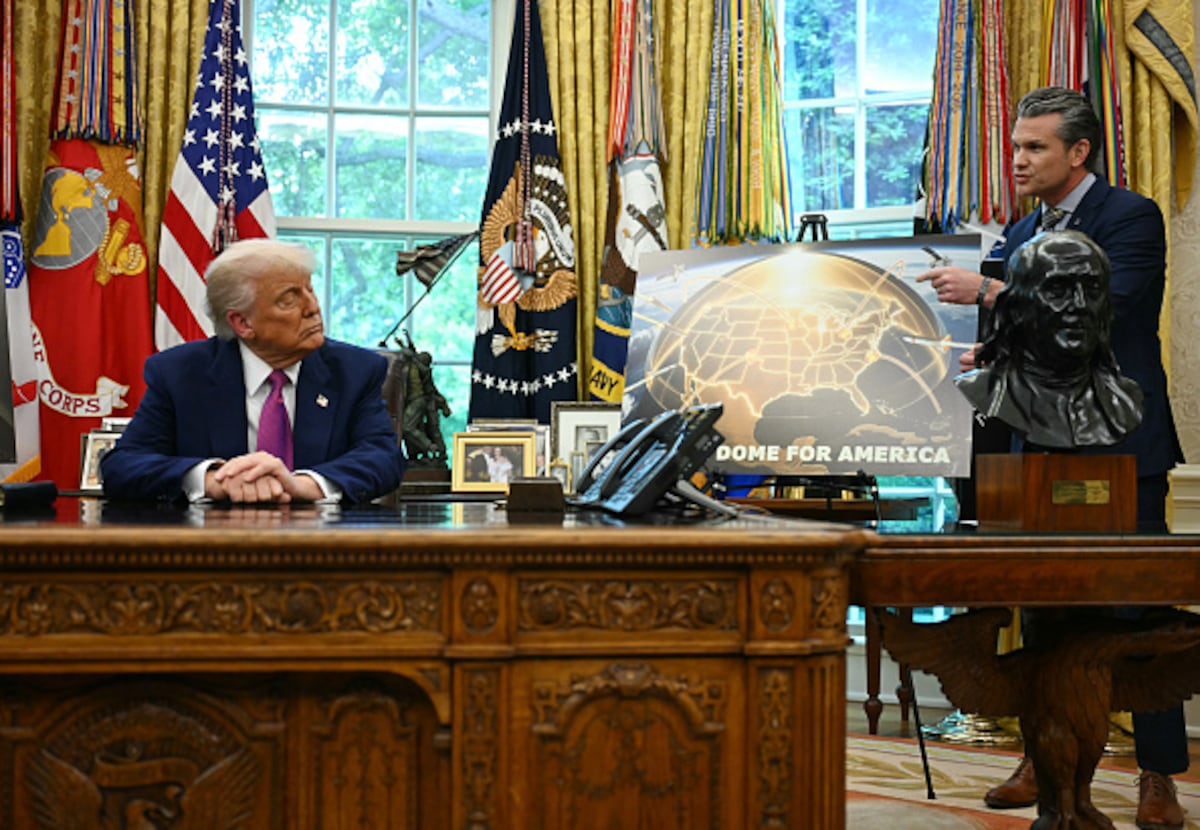Defense Secretary Pete Hegseth’s decision this week to cut more than half of the Pentagon’s test and evaluation office personnel was driven, in part, by concerns over the office’s plans to provide testing oversight for the Trump administration’s $175 billion Golden Dome missile defense project, multiple sources told Defense News.
In a memo released Wednesday, Defense Secretary Pete Hegseth announced plans to restructure the Office of the Director of Operational Test and Evaluation, known as DOT&E, and reduce its 94-person staff to 46 — a mix of civilians, military personnel and one senior executive. The memo also put an end to all contractor support to the office.
The decision sparked concerns from some congressional Democrats, including Senate Armed Services Committee Ranking Member Jack Reed, D-RI, who called the move “reckless and damaging.”
“With staffing reduced to a skeleton crew and limited contractor backing, DOT&E may be unable to provide adequate oversight for critical military programs, risking operational readiness and taxpayer dollars,” Reed said in a statement. “This kind of politically motivated interference undermines independent oversight and leaves warfighters and the public more vulnerable to untested, potentially flawed systems.”
Hegseth said the reorganization is tied to the Pentagon’s “America First” strategy and was backed by an internal review that identified “redundant, non-statutory functions” within the office. The analysis, he said, found that reducing personnel could save more than $300 million per year.
But multiple sources familiar with the decision and granted anonymity to speak freely told Defense News the circumstances are more complicated than the scenario the secretary described in his memo. They pointed to perennial tensions between the military services and the office, stoked in recent months by an atmosphere of touting quick, programmatic successes that is antithetical to the exacting mission of verifying performance claims over time and under varying conditions.
The sources also cited senior leadership’s frustration with DOT&E’s recent decision to add Golden Dome to its “oversight list” as being the final provocation.
“It’s a perfect storm,” one source said.
Mandated oversight
The DOT&E office was created by Congress to provide independent oversight of major defense acquisition programs. Its leaders are required by law to approve testing plans and report results for all Defense Department programs whose total research and development cost exceeds $525 million —in 2020 dollars — or whose procurement is expected to cost more than $3 billion.
The list of efforts under DOT&E oversight currently features over 250 programs, including the F-35 Joint Strike Fighter, the Army’s Long-Range Hypersonic Weapon and the Navy’s Aegis modernization program.
The office’s role as an overseer means its recommendations are sometimes unpopular with military service leaders and major defense contractors alike. But the aim of its rigorous, and often arduous, validation is to prevent the department from fielding faulty systems that could put service members in harm’s way.
Golden Dome’s cost — estimated at $175 billion over the next three years — and its complexity make it a clear candidate for DOT&E oversight, the sources said.
The process for initiating DOT&E oversight of a program is fairly straightforward, but when DOT&E’s Acting Director Raymond O’Toole notified senior leaders in a recent memo that he planned to add Golden Dome to the list, the decision drew an unusual level of scrutiny.
Officials worried the office’s involvement would slow the program down and drive up its cost. They eventually elevated their concerns to the White House.
That extra attention appears linked to President Donald Trump’s interest in the program, one source said, noting the office was told the program “needed to be successful for Mr. Trump.”
Pet project
Golden Dome became the president’s signature defense project early in his second term. In a Jan. 27 memo, he directed the Pentagon to draft a plan for a layered network of ground-and space-based interceptors and sensors to detect, track and defeat a range of missile threats.
Initially calling the project “Iron Dome for America” after Israel’s missile defense system of the same name, Trump rebranded it to “Golden Dome” — a nod to his vision for a “golden age in America” and perhaps his own penchant for the precious metal.
In an Oval Office meeting last week, flanked by Hegseth and a top Space Force general — as well as multiple images depicting a map of the U.S. covered in gold — Trump said the Pentagon would deliver “the best system ever built” before the end of his term.
While there is wide agreement among defense officials and outside experts that the U.S. needs a more focused investment in its missile defense architecture, Trump’s schedule and cost projections have raised eyebrows.
With actual details on the project still slim, some have questioned whether Golden Dome’s biggest technological lifts are feasible and worth the long-term cost.
“I don’t think we should read much into the $175 billion figure because no details or caveats were provided,” said Todd Harrison, an analyst at the American Enterprise Institute. “I want to see something on paper that shows what’s included, what’s not included, and the time frame of the estimate.”
This week’s DOT&E cuts likely mean the office will be under-resourced to oversee all of the Defense Department’s major programs, let alone Golden Dome.
One source familiar with the office speculated the “drastically reduced” staff could allow the Pentagon to get away with slimming down the office’s oversight list.
Reduced testing oversight could allow Golden Dome to move faster, but sources said it would be concerning for a program with such high-stakes ambitions to escape scrutiny.
“It would be hundreds of warheads coming in with all kinds of countermeasures, cyber attacks,” another source said. “That’s usually beyond the scope of a program and a service test office to be able to orchestrate all that.”
Courtney Albon is C4ISRNET’s space and emerging technology reporter. She has covered the U.S. military since 2012, with a focus on the Air Force and Space Force. She has reported on some of the Defense Department’s most significant acquisition, budget and policy challenges.
Read the full article here





